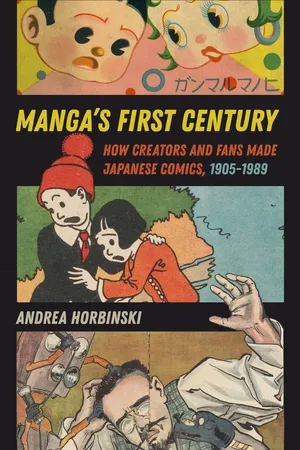
eBook - ePub
Manga's First Century
How Creators and Fans Made Japanese Comics, 1905–1989
- English
- ePUB (mobile friendly)
- Available on iOS & Android
eBook - ePub
About this book
A comprehensive English-language history of a beloved medium, Manga’s First Century tells the story of the artists and fans who built a cultural juggernaut.
Manga is the world’s most popular style of comics. How did manga and anime—“moving manga”—become ubiquitous? Manga’s First Century delves into the history and finds surprising answers.
In fact, manga has always been a global phenomenon. Countering essentialist myths of manga’s emergence from the deepest wells of Japanese art, author Andrea Horbinski shows it was born in the early 1900s, a hybrid form that crossed single-panel satirical cartoons popular in Europe and America with the Edo period’s artistic legacy. As a medium, manga initially focused on political commentary, expanding to include social satire, children’s comics, and proletarian art in the 1920s and 1930s. Manga’s evolution into a medium embracing complex, long-form storytelling was likewise driven by creators and fans pushing publishers to accept new, radical expansions in manga’s artistic and narrative practices. In the 1970s, innovative creators and fans empowered a new breed of fan-generated comics (dōjinshi) and established robust audiences of adult, female, and queer manga readers, while nurturing generations of amateur and professional creators who continue to enrich and renew manga today.
Manga is the world’s most popular style of comics. How did manga and anime—“moving manga”—become ubiquitous? Manga’s First Century delves into the history and finds surprising answers.
In fact, manga has always been a global phenomenon. Countering essentialist myths of manga’s emergence from the deepest wells of Japanese art, author Andrea Horbinski shows it was born in the early 1900s, a hybrid form that crossed single-panel satirical cartoons popular in Europe and America with the Edo period’s artistic legacy. As a medium, manga initially focused on political commentary, expanding to include social satire, children’s comics, and proletarian art in the 1920s and 1930s. Manga’s evolution into a medium embracing complex, long-form storytelling was likewise driven by creators and fans pushing publishers to accept new, radical expansions in manga’s artistic and narrative practices. In the 1970s, innovative creators and fans empowered a new breed of fan-generated comics (dōjinshi) and established robust audiences of adult, female, and queer manga readers, while nurturing generations of amateur and professional creators who continue to enrich and renew manga today.
Frequently asked questions
Yes, you can cancel anytime from the Subscription tab in your account settings on the Perlego website. Your subscription will stay active until the end of your current billing period. Learn how to cancel your subscription.
At the moment all of our mobile-responsive ePub books are available to download via the app. Most of our PDFs are also available to download and we're working on making the final remaining ones downloadable now. Learn more here.
Perlego offers two plans: Essential and Complete
- Essential is ideal for learners and professionals who enjoy exploring a wide range of subjects. Access the Essential Library with 800,000+ trusted titles and best-sellers across business, personal growth, and the humanities. Includes unlimited reading time and Standard Read Aloud voice.
- Complete: Perfect for advanced learners and researchers needing full, unrestricted access. Unlock 1.4M+ books across hundreds of subjects, including academic and specialized titles. The Complete Plan also includes advanced features like Premium Read Aloud and Research Assistant.
We are an online textbook subscription service, where you can get access to an entire online library for less than the price of a single book per month. With over 1 million books across 1000+ topics, we’ve got you covered! Learn more here.
Look out for the read-aloud symbol on your next book to see if you can listen to it. The read-aloud tool reads text aloud for you, highlighting the text as it is being read. You can pause it, speed it up and slow it down. Learn more here.
Yes! You can use the Perlego app on both iOS or Android devices to read anytime, anywhere — even offline. Perfect for commutes or when you’re on the go.
Please note we cannot support devices running on iOS 13 and Android 7 or earlier. Learn more about using the app.
Please note we cannot support devices running on iOS 13 and Android 7 or earlier. Learn more about using the app.
Yes, you can access Manga's First Century by Andrea Horbinski in PDF and/or ePUB format, as well as other popular books in Literature & Asian Art. We have over one million books available in our catalogue for you to explore.
Information
Table of contents
- Title
- Copyright
- Subvention
- Dedication
- Contents
- List of Illustrations
- Acknowledgments
- Note on Names, Styles, and Terms
- Introduction
- Part One: Origins, 1905–1928
- Part Two: Manga During Wartime, 1928–1945
- Part Three: Manga in the Postwar Era, 1945–1963
- Part Four: TV Manga and the Age of Revolution, 1963–1975
- Part Five: Manga Turns Postmodern, 1975–1989
- Conclusion: A Distinctive History
- Note on Sources
- Glossary
- Notes
- Bibliography
- Index